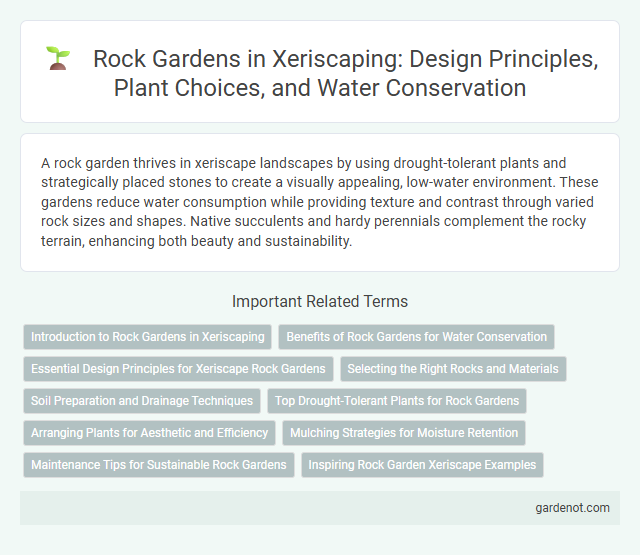A rock garden thrives in xeriscape landscapes by using drought-tolerant plants and strategically placed stones to create a visually appealing, low-water environment. These gardens reduce water consumption while providing texture and contrast through varied rock sizes and shapes. Native succulents and hardy perennials complement the rocky terrain, enhancing both beauty and sustainability.
Introduction to Rock Gardens in Xeriscaping
Rock gardens in xeriscaping use drought-tolerant plants arranged among natural stones to create low-water, visually striking landscapes. Incorporating native succulents, ornamental grasses, and seasonal wildflowers, these gardens enhance soil drainage and reduce irrigation needs. Strategic placement of rocks stabilizes soil and provides microclimates, promoting sustainable plant growth in arid environments.
Benefits of Rock Gardens for Water Conservation
Rock gardens significantly reduce water consumption by utilizing drought-tolerant plants and minimizing soil evaporation with strategically placed rocks. Their design enhances soil moisture retention and directs rainwater efficiently, making them ideal for xeriscaping in arid regions. Integrating native succulents and hardy perennials further optimizes water conservation while creating visually appealing landscapes.
Essential Design Principles for Xeriscape Rock Gardens
Xeriscape rock gardens emphasize water conservation by incorporating drought-tolerant plants, efficient soil amendments, and strategic rock placement to reduce evaporation and runoff. Essential design principles include selecting rocks of varying sizes to create natural focal points, optimizing plant spacing for airflow and sunlight, and using mulch to preserve soil moisture. Incorporating native or adapted plants enhances sustainability, while careful grading ensures proper drainage and prevents water pooling.
Selecting the Right Rocks and Materials
Selecting the right rocks and materials is essential for a successful xeriscape rock garden, emphasizing durability, size variety, and color harmony to enhance both function and aesthetics. Incorporate native stones that retain heat and improve soil drainage while requiring minimal maintenance, such as flagstone, river rocks, and decomposed granite. Proper layering with landscape fabric underneath prevents weed growth and maintains soil moisture, contributing to the garden's sustainability in arid environments.
Soil Preparation and Drainage Techniques
Effective soil preparation for a rock garden in xeriscaping involves loosening the soil to a depth of at least 12 inches and incorporating coarse sand or gravel to enhance aeration and water permeability. Proper drainage techniques include creating a slight slope or raised beds to prevent water accumulation and installing drainage pipes or layers of crushed rock beneath the soil to facilitate rapid water runoff. These methods help maintain optimal moisture balance, critical for drought-tolerant plants commonly used in xeriscape rock gardens.
Top Drought-Tolerant Plants for Rock Gardens
Rock gardens thrive with top drought-tolerant plants such as Sedum, Agave, and Yucca, which require minimal water and withstand harsh conditions. Succulents like Sempervivum and drought-hardy perennials including Lavender and Russian Sage enhance soil retention and add vibrant textures. Incorporating native xeriscape plants further optimizes water conservation while maintaining aesthetic appeal in rock garden landscapes.
Arranging Plants for Aesthetic and Efficiency
Strategically arranging drought-tolerant plants in a rock garden enhances both visual appeal and water efficiency by grouping species with similar moisture needs. Incorporating succulents, native grasses, and low-water perennials among natural stone formations creates layered textures and vibrant focal points. Proper placement maximizes sunlight exposure and drainage, reducing irrigation requirements while promoting sustainable xeriscaping practices.
Mulching Strategies for Moisture Retention
Rock gardens benefit significantly from mulching strategies that enhance moisture retention by reducing evaporation and regulating soil temperature. Using inorganic mulches such as gravel or decomposed granite around drought-tolerant plants supports xeriscape principles while improving water efficiency. These mulches create a protective layer that conserves soil moisture, minimizes weed growth, and promotes healthier root systems in arid environments.
Maintenance Tips for Sustainable Rock Gardens
Rock garden maintenance for xeriscape involves regular weeding and ensuring proper drainage to prevent water accumulation around rocks, which can cause plant root rot. Use mulch or gravel to suppress weeds and retain soil moisture, reducing the need for frequent watering. Periodic pruning of drought-tolerant plants and checking for erosion help maintain the garden's sustainability and aesthetic appeal.
Inspiring Rock Garden Xeriscape Examples
Inspiring rock garden xeriscape examples showcase low-water landscaping with drought-tolerant plants and creative stone arrangements to enhance natural beauty and sustainability. These designs incorporate native succulents, ornamental grasses, and textured rocks that reduce irrigation needs while providing visual interest year-round. Effective xeriscape rock gardens prioritize soil retention and moisture conservation, promoting eco-friendly outdoor spaces in arid climates.
Rock garden Infographic

 gardenot.com
gardenot.com